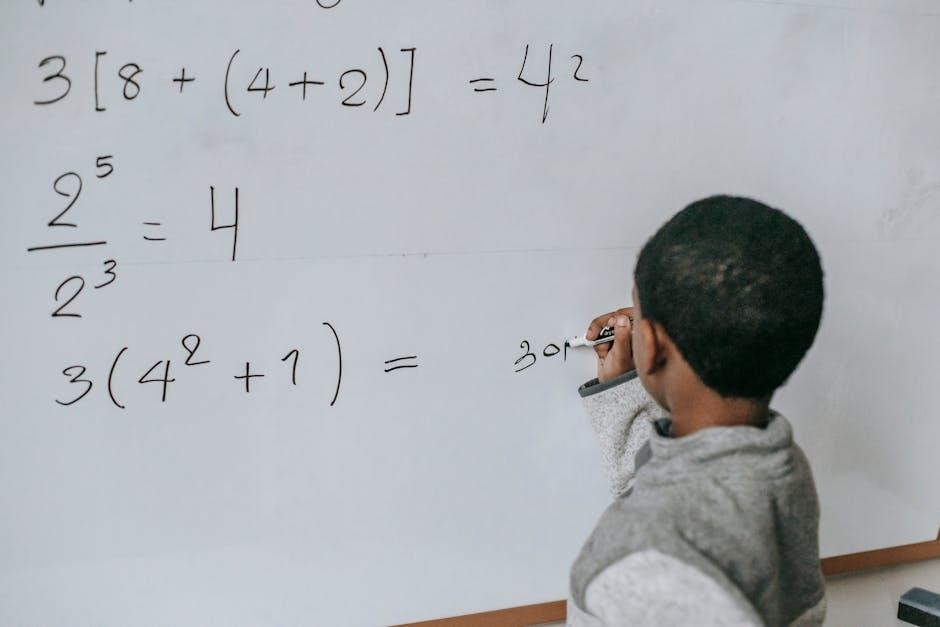One-step equations are straightforward algebraic problems requiring a single operation to isolate the variable. They involve basic operations like addition, subtraction, multiplication, or division, and are solved by using inverse operations to simplify the equation. These equations are fundamental in building foundational math skills and are widely used in real-world applications, including geometry and everyday problem-solving scenarios.
1.1 Definition and Importance
One-step equations are algebraic expressions requiring a single mathematical operation to solve. They involve variables and constants, with the goal of isolating the variable on one side of the equation. These equations are foundational in algebra, teaching students to apply inverse operations and maintain balance in equations. Solving one-step equations is essential for developing problem-solving skills, as they form the basis for more complex algebraic concepts. They are widely used in real-world scenarios, such as calculating measurements, determining unknown quantities, and solving everyday problems. Mastering one-step equations builds confidence and prepares students for advanced mathematical challenges, emphasizing critical thinking and logical reasoning. Their simplicity makes them an ideal starting point for understanding algebraic principles.

1.2 Basic Principles of Solving Linear Equations
The foundation of solving one-step equations lies in applying inverse operations to isolate the variable. For addition or subtraction, use the opposite operation. For multiplication or division, use the reciprocal. Start with the given equation, identify the operation applied to the variable, and apply the inverse to both sides. Ensure balance by performing the same operation on both sides. Simplify step-by-step, checking the solution by substitution to confirm equality. This systematic approach ensures accuracy and builds a strong understanding of algebraic principles.

Solving One-Step Equations with Addition and Subtraction
2.1 Addition Property of Equality
The Addition Property of Equality states that if you add the same number to both sides of an equation, the equation remains balanced. This principle is crucial for solving one-step equations involving addition. For example, in the equation ( x ⎯ 5 = 10 ), adding 5 to both sides isolates the variable, resulting in ( x = 15 ). This property ensures that the equation’s truth value remains unchanged, allowing for accurate solutions. It is a foundational concept in algebra, enabling students to understand how to manipulate equations to find unknown values. By applying this property, students can confidently solve a variety of one-step equations, building a strong foundation for more complex algebraic problems.
2.2 Solving Equations with Negative Integers
Solving one-step equations involving negative integers requires careful application of inverse operations. For example, in the equation ( x + (-5) = 10 ), subtracting -5 from both sides is equivalent to adding 5, resulting in ( x = 5 ). Similarly, in equations like ( y ⎯ 8 = -3 ), adding 8 to both sides isolates the variable, yielding ( y = 5 ). Understanding how to handle negative integers is essential for maintaining balance in equations. These problems often appear in real-world scenarios, such as calculating temperatures or financial losses. Mastering this skill builds confidence in solving more complex algebraic problems and prepares students for advanced mathematical concepts.

Solving One-Step Equations with Multiplication and Division
One-step equations involving multiplication or division require using inverse operations to isolate the variable. For multiplication, divide both sides by the coefficient, and for division, multiply both sides by the divisor. This ensures the equation remains balanced while solving for the variable efficiently.
3.1 Using Inverse Operations
Inverse operations are essential for solving one-step equations involving multiplication and division. To isolate the variable, apply the inverse operation to both sides of the equation. For example, if the equation involves multiplication, divide both sides by the same number to maintain balance. Similarly, if the equation involves division, multiply both sides by the divisor. This ensures the equation remains equivalent while simplifying it to find the value of the variable. Using inverse operations systematically helps in solving equations efficiently and accurately, whether dealing with integers, fractions, or mixed numbers. This method is fundamental for understanding more complex algebraic concepts in the future.
3.2 Solving Equations Involving Fractions and Mixed Numbers
Solving one-step equations with fractions and mixed numbers requires careful application of inverse operations. When dealing with fractions, multiply or divide by the reciprocal to isolate the variable. For mixed numbers, convert them to improper fractions first to simplify the equation. Ensure all terms are in the same format before performing operations. This method maintains equation balance and leads to accurate solutions. Practice with various exercises helps build proficiency in handling different numerical formats, reinforcing algebraic principles. Understanding these steps is crucial for tackling more complex equations in the future.

Solving One-Step Equations with Integers
Solving one-step equations with integers involves using inverse operations to isolate the variable. Positive and negative integers require careful handling to maintain equation balance and achieve accurate solutions.
4.1 Solving Equations with Positive and Negative Results
Solving one-step equations with integers involves working with both positive and negative results. When solving equations like v – 10 = 9 or x / 3 = 4, the goal is to isolate the variable using inverse operations. For positive results, adding, subtracting, multiplying, or dividing directly yields the solution. Negative results require careful attention to the signs to ensure the equation remains balanced. For example, in v – 10 = -9, adding 10 to both sides results in v = 1. Similarly, in x / -2 = 3, multiplying both sides by -2 gives x = -6. These problems enhance understanding of integer operations and their applications in real-world scenarios, emphasizing the importance of precise calculations and checking solutions by substitution.
4.2 Word Problems Involving One-Step Equations
Word problems involving one-step equations require translating real-world scenarios into mathematical expressions. For example, if a problem states, “A bookshelf weighs 15 pounds less than a table,” and the table weighs 30 pounds, the equation 15 + x = 30 can be used to find the bookshelf’s weight. Solving such problems involves identifying the operation implied by the context and applying the appropriate inverse operation. Practical applications include calculating distances, solving for unknown quantities in recipes, or determining weights. These problems enhance critical thinking and the ability to interpret and solve mathematical situations encountered in everyday life, making one-step equations a valuable tool for real-world problem-solving.

Real-World Applications of One-Step Equations
One-step equations are essential in real-world scenarios, such as calculating distances, solving measurement problems, and determining unknown quantities in recipes or construction projects, enhancing practical problem-solving skills.
5.1 Geometry and Measurement Problems
One-step equations are invaluable in solving geometry and measurement problems, where unknown quantities often need to be determined. For instance, finding the length of a room when the total area and width are known, or calculating the height of a triangle when the base and area are provided, can be efficiently solved using one-step equations. These equations simplify the process of isolating the unknown variable, making it easier to find precise measurements. Additionally, in word problems involving distances, speeds, or volumes, one-step equations provide a straightforward method to compute the desired value. By applying inverse operations, students can quickly and accurately solve for unknowns in various geometric and real-world measurement scenarios, enhancing their problem-solving abilities. These practical applications highlight the importance of mastering one-step equations in everyday mathematics.
5.2 Solving for Unknowns in Everyday Scenarios
One-step equations are practical tools for solving unknowns in everyday scenarios, making math accessible and applicable to real life. For instance, calculating the cost of items on sale, determining the time it takes to travel a certain distance, or figuring out the correct ingredients for a recipe can all be simplified using one-step equations. These equations help individuals manage budgets, plan events, and solve common problems efficiently. Whether it’s doubling a recipe, calculating discounts, or measuring materials for a DIY project, one-step equations provide a straightforward method to find solutions quickly and accurately. This real-world relevance makes learning and applying one-step equations both meaningful and essential for everyday decision-making.

Resources for Practicing One-Step Equations
Various resources are available for practicing one-step equations, including printable PDF worksheets and online interactive tools. These provide comprehensive practice and immediate feedback to enhance learning.
6.1 Printable PDF Worksheets
Printable PDF worksheets are an excellent resource for practicing one-step equations. These worksheets are widely available online and can be downloaded for free. Many worksheets include a variety of problems involving addition, subtraction, multiplication, and division, catering to different skill levels. They often come with answer keys, allowing students to check their work and track progress. Some PDFs also include step-by-step examples and detailed instructions, making them ideal for self-study or classroom use. Worksheets are organized by topics, such as solving equations with integers, fractions, or mixed numbers, ensuring focused practice. They are a convenient and effective way to reinforce understanding and build confidence in solving one-step equations.

6.2 Online Tools and Interactive Tutorials
Online tools and interactive tutorials provide a modern and engaging way to practice solving one-step equations. Websites like Khan Academy, Mathway, and IXL offer step-by-step solutions, video tutorials, and interactive exercises. These platforms allow students to input their answers and receive immediate feedback, helping them identify mistakes and improve their understanding. Many tools also include progress tracking, making it easier to monitor learning over time. Additionally, interactive whiteboard resources and educational apps like Photomath and Desmos offer visual and hands-on approaches to solving equations. These digital resources are particularly useful for visual learners and those who prefer self-paced study. They are accessible anywhere with an internet connection, making them a flexible option for practicing one-step equations.
